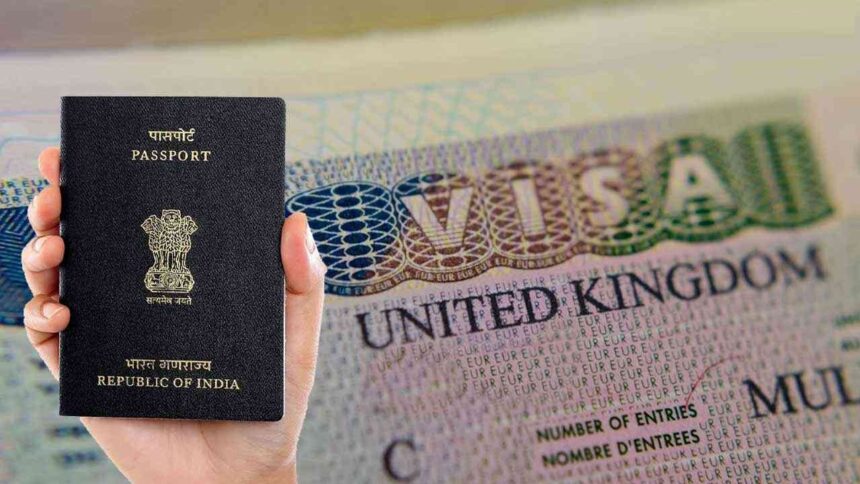LONDON – The United Kingdom, once a leading choice for Indian students, is now seeing a steep fall in UK Visa numbers. Recent figures from the Home Office show a 42 percent decrease in student visa applications from India in 2024.
Only 92,355 study visas were granted, dropping from 159,371 in 2023. This significant fall is part of a wider trend, with work visas also declining, leading many to question the UK’s future as an education hub for Indian students.
What’s Behind the UK Visa Drop?
For years, students from India viewed the UK as a place to earn a respected degree, enjoy a mix of cultures, and take advantage of post-study work through the Graduate Route visa. But things have changed quickly. New rules and other pressures have forced many to reconsider.
Tighter Immigration Rules: Since January 2024, the UK has placed strict limits on international students bringing dependents. Only those on certain research-based postgraduate courses or government-funded scholarships can include family members.
Home Office data shows this move caused dependent visa applications to fall by 86 percent between December 2023 and July 2025. Bringing family offered a path to settle for many Indian students, but the new restriction closed that door for most. Amit Tiwari, President of the Indian National Students’ Association UK, explains, “Students with families no longer see the UK as an option.”
Harder to Get a Job: Economic issues and a sense of few job openings are keeping students away. Sanam Arora of the National Indian Students and Alumni Union UK points to doubts around the Graduate Route visa and ongoing reports of limited jobs. Recent anti-immigration unrest in some UK cities has also raised worries about safety, making the country less appealing.
Rising Costs and Attractive Rivals: University fees and living costs in the UK remain high. Other countries like Canada and Australia are drawing more interest, thanks to lower costs, easier work permits, and simpler visa steps. Education adviser Priya Sharma says, “Australia has better financial support and work after graduation. Canada’s system is also clearer, which many students prefer.”
Unstable Policy: The UK government keeps reviewing its student routes and work rules, making it hard for students to plan. While the Graduate Route visa was kept in 2024 after talks of its removal, pay requirements for the Skilled Worker visa jumped to £41,700, blocking many from staying to work.
Impact on Universities
Universities in the UK rely on international student fees to cover costs. With this decline, the Office for Students warns of a possible £1.6 billion gap by 2025-26. Campuses that attract the most Indian, Nigerian, and Bangladeshi students could be hit hardest.
How Indian Students Apply for the UK Visa
Despite the drop, some Indian students still want to study in the UK. The visa process (known as the Tier 4 General Student Visa) needs careful planning. The main steps in 2025:
- Get an Offer: Secure a place at a UK university and receive a Confirmation of Acceptance for Studies (CAS).
- Gather Documents: Have a passport, proof of funds (at least £1,334 monthly for London or £1,023 elsewhere), evidence of tuition payment, a tuberculosis test if needed, and English test results like IELTS or TOEFL.
- Apply Online: Complete forms on the UK government site. The current fee is £490, with an extra £776 per year for healthcare.
- Biometric Appointment: Attend an appointment in India to submit fingerprints and a photo. Some students may be called for a further interview.
- Wait for Approval: Once approved, the visa covers the course plus a few extra months. Courses over 12 months allow students to apply for the Graduate Route visa for two more years of work in the UK.
Sanam Arora says, “The visa process itself is simple enough. What’s changed is the high cost, job worries, and new rules about dependants.”
Trends Beyond the UK
Fewer Indian students wanting a UK visa is not the only sign of change. Net migration to the UK fell by 431,000 in 2024, with 37,000 Indian students and 18,000 workers leaving the country. As the UK and US introduce tighter controls, more Indian students now look to Canada, Australia, Germany, and Ireland for study and work options.
Education specialist Priya Sharma puts it simply, “Many students saw the UK as a way to build a global career. Now they want countries that offer a fair deal, from good teaching to better work prospects.”
What Next for UK Universities?
Losing Indian students puts income at risk for many UK universities. The Office for Students predicts that up to 72 percent of universities could face deficits by 2026 if numbers stay low. To rebuild trust, universities will need to improve job support, share clear information about visa rules, and reconnect with students in India.
For Indian families, choosing a university abroad is about more than rankings. They want a safe, affordable place that gives a real chance to settle and work after graduation. Whether UK universities can win back these students will depend on future policy changes and how they respond to growing competition.
Related News:
The UK Government Is Considering Auctioning Bitcoin for £5 billion to Cover Its Fiscal Deficit.














